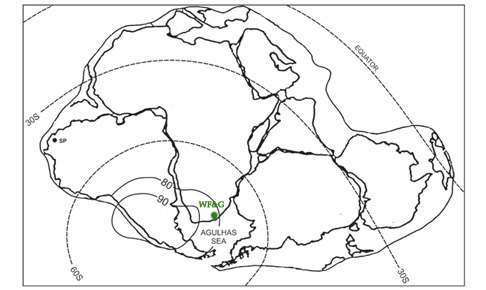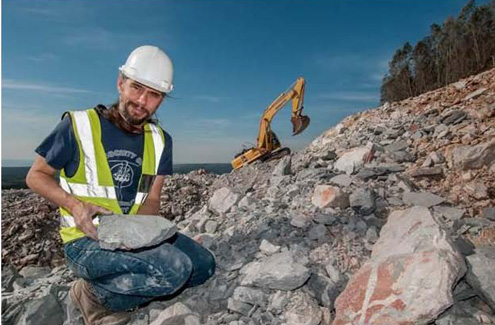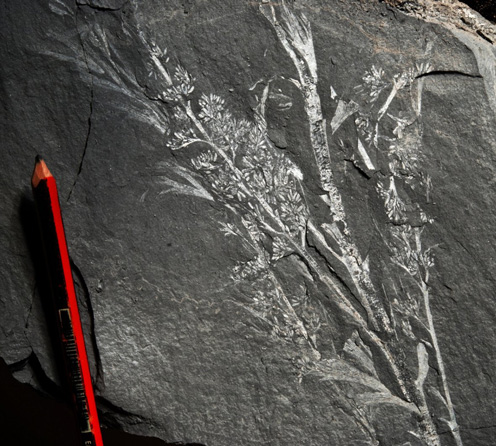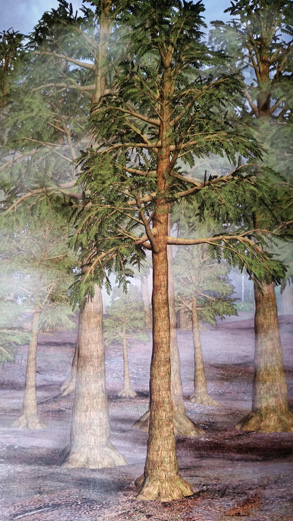New Roadway Leads to Devonian Deposit
“Treasure Trove” of Devonian Fossil Material Discovered During Road Construction
Upgrading a portion of a major trunk road in the Eastern Cape province of South Africa has enabled palaeontologists to get a rare insight into the flora and fauna of an ancient Devonian ecosystem. In a press release sent to Everything Dinosaur by the South African National Roads Agency SOC Ltd (SANRAL), the creation of a cutting as part of road improvements, has exposed a highly fossiliferous shale deposit containing fossils of both plants and animals that lived more than 360 million years ago.
Roadworks Uncovers a Devonian Deposit
Picture credit: SANRAL
The photograph above shows palaeontologist Dr Robert Gess (Albany Museum in Grahamstown), with 360-million-year-old invertebrate and plant fossils discovered outside Grahamstown, Eastern Cape province.
Ms Mpati Makoa, a spokeswoman for SANRAL stated:
“A number of new invertebrates as well as excellently preserved plant fossils of the Devonian Period have been excavated and discovered in rock debris of the Witpoort Formation along the N2 between Grahamstown and Fish River.”
“Many Species have not yet been Documented by Palaeontologists”
The fossils represent a marine coastline ecosystem when what is now Eastern Cape was located at a much higher latitude, some fifteen degrees off the South Pole. Africa formed part of a huge, southern super-continent (Gondwana) that consisted of land that would eventually become South America, Antarctica, Arabia, Australia and southern Asia. This fossil site is especially significant as during the Devonian there was a great increase and diversity in terrestrial plants, which gradually spread inland from the coastal swamps. Many of the fossil finds, although not studied in great detail to date, indicate that there are a number of new species of plant and invertebrate likely to be documented.
Beautifully Preserved Evidence of Late Devonian Terrestrial Plants
Picture credit: SANRAL
According to Dr Gess, the plant and invertebrate fossil discoveries are from ancient open river mouth ecosystems.
Dr Gess stated:
“It differs from the fossil discoveries of the closed lagoon ecosystem of Waterloo Farm, an important South African palaeontological heritage site of the Late Devonian period which is around twenty kilometres away from the current excavation site where SANRAL is working. The discovery is significant as palaeontological research and scholarship on marine ecosystems of the Devonian Period was primarily anchored in the fossil discoveries of Waterloo Farm. Now, we are able to trace a much broader picture of life along an ancient coastline through the discovery of new plant and invertebrate species.”
An Illustration Showing the Approximate Location of the Waterloo Farm and Grahamstown Fossil Sites (Devonian Period)

The location of Waterloo Farm and Grahamstown where a substantial number of Devonian fossils have been found.
Picture credit: University of Witwatersrand with additional annotation by Everything Dinosaur
Late Devonian Fossils
Commenting on the fossil flora found so far, Dr Gess explained:
“We have collected the remains of a shrub sized Iridopterid plant, from the group that was ancestral to modern horsetail plants. Interestingly, while Iridopteralians were located both at Waterloo Farm and the current fossil excavation site, they are different, though both are undescribed species. In addition, a number of types of clubmosses (lycopods) that formed patches of knee height branching stalks resembling bristling cat’s tails have been discovered and collected at the current site, as well as Zosterophylopsid plants.”
The team also retrieved the most complete specimens of the “fronds” of the Archaeopteris notosaria tree, which according to Dr Gess is “the best preserved fertile material of this ancient tree on record”.
An Illustration of the Ancient Tree Archaeopteris notosaria
Marine Invertebrate Fossils
Dr Gess and his field team have also discovered a number of new marine invertebrates.
The doctor stated:
“We are busy describing a new species of bivalve or mud clam from Waterloo Farm. However, at the new outcrops we are dealing with an entirely different bivalve that has never before been found.”
Just a few kilometres west of the main plant fossil localities and in slightly older strata, the field team also discovered linguloid brachiopod shells.
“Linguloid brachiopods were invertebrates that lived in burrows and had a long fleshy foot. When found without other types of marine invertebrates they indicate a marine environment with some fresh water input. They have never before been found in this age strata.”
Roadworks Play a Huge Role in Exploring South Gondwana in the Late Devonian
A series of road repair and construction projects in this part of the Eastern Cape over the last two decades has helped palaeontologists to piece together prehistoric ecosystems from approximately 360 million years ago. For example, twenty species of Late Devonian fish have been found at the Waterloo Farm roadworks, these fossils have been found nowhere else in the world. In addition, the Waterloo Farm site has yielded fossils of terrestrial, freshwater flora and marine seaweeds plus invertebrate fossils representing the ancestors of today’s spiders and scorpions.
Dr Gess explained that the black shale in which the fossils are found is very prone to weathering and in nature it is turned to formless clay before it reaches the surface of the ground.
“Roadworks, though, give the opportunity for palaeontologists to, as it were, reach deep into the landscape and retrieve fresh unweathered shale,” he said.
SANRAL plans to introduce a resting place and observation area along the N2 road so that members of the public can view the fossil site and learn about South Africa’s ancient past.
Everything Dinosaur acknowledges the assistance of a media release from the South African National Roads Agency SOC Ltd (SANRAL) in the compilation of this article.
Visit Everything Dinosaur’s website: Everything Dinosaur.




